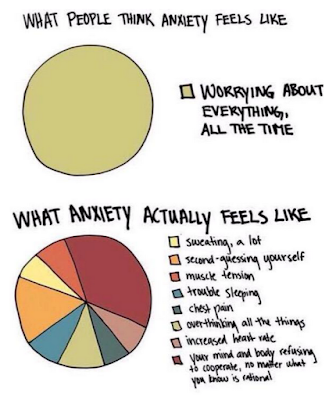Yu-Han Chao's Blog, page 8
January 25, 2019
4.2. Phobia = fear
Some of us may have started first semester of nursing school with an irrational fear of needles, but by now, we have bigger problems ("Just stick me.")
Plus we're getting better at IV insertions so there's less DIGGING AROUND IN EACH OTHER'S VEINS, fewer bruises, and more neat little scabs on the dorsal palmar venous arch.
There are plenty more fears to overcome, however.
Acrophobia = fear of heights
Ailurophobia = fear of cats (the "Cat Spring Roll" story in my collection, Sex & Taipei City, is for you, non-lovers of cats.)
Algophobia = fear of pain (as opposed to those of us who apparently enjoy it)
Anthophobia = fear of flowers (and we're not talking about allergies)
Astraphobia = fear of lightening
Belonephobia = fear of needles (and bologna?) Also: Trypanophobia = fear of needles, injections & blood draws.
Brontophobia = fear of thunder (Raindrops on roses and whiskers on kittens...)
 Cynophobia = fear of dogs (esp. if a dog tried to eat your face)
Cynophobia = fear of dogs (esp. if a dog tried to eat your face)
Dementophobia = fear of insanity
Gamophobia = fear of marriage (no comment)
Herpetophobia = fear of lizards & reptiles (not herpes)
Murophobia = fear of mice (not Murakami books)
Mysophobia = fear of dirt, germs, contamination
Monophobia = fear of being alone (Moms with young children generally don't have this problem.)
Nyctophobia = fear of riding in a car (with boys)
Ophidiophobia = fear of snakes
Scoleciphobia = fear of worms
Siderodromophobia = fear of railroads or train travel (well, there are some interesting folk on the Amtrak...)
Taphophobia = fear of being buried alive (seems reasonable)
Trichophobia = fear of hair (random loose hairs, that is, not long, blonde ones found on your husband's coat, specifically.)
Triskaidekaphobia = fear of the number 13
These phobias can be "treated" in many ways. There's individual psychotherapy for insight and cognitive therapy for subjective appraisal. Behavioral therapies such as relaxation training, modeling (behavior, not clothing), systematic desensitization (increased exposure), flooding (merciless immersion), response prevention and thought stopping (replace negative thought with positive one) have been effective.
One can also just avoid the thing one fears irrationally, which seems quite rational and a lot less trouble...
Plus we're getting better at IV insertions so there's less DIGGING AROUND IN EACH OTHER'S VEINS, fewer bruises, and more neat little scabs on the dorsal palmar venous arch.
There are plenty more fears to overcome, however.
Acrophobia = fear of heights
Ailurophobia = fear of cats (the "Cat Spring Roll" story in my collection, Sex & Taipei City, is for you, non-lovers of cats.)
Algophobia = fear of pain (as opposed to those of us who apparently enjoy it)
Anthophobia = fear of flowers (and we're not talking about allergies)
Astraphobia = fear of lightening
Belonephobia = fear of needles (and bologna?) Also: Trypanophobia = fear of needles, injections & blood draws.
Brontophobia = fear of thunder (Raindrops on roses and whiskers on kittens...)
 Cynophobia = fear of dogs (esp. if a dog tried to eat your face)
Cynophobia = fear of dogs (esp. if a dog tried to eat your face)Dementophobia = fear of insanity
Gamophobia = fear of marriage (no comment)
Herpetophobia = fear of lizards & reptiles (not herpes)
Murophobia = fear of mice (not Murakami books)
Mysophobia = fear of dirt, germs, contamination
Monophobia = fear of being alone (Moms with young children generally don't have this problem.)
Nyctophobia = fear of riding in a car (with boys)
Ophidiophobia = fear of snakes
Scoleciphobia = fear of worms
Siderodromophobia = fear of railroads or train travel (well, there are some interesting folk on the Amtrak...)
Taphophobia = fear of being buried alive (seems reasonable)
Trichophobia = fear of hair (random loose hairs, that is, not long, blonde ones found on your husband's coat, specifically.)
Triskaidekaphobia = fear of the number 13
These phobias can be "treated" in many ways. There's individual psychotherapy for insight and cognitive therapy for subjective appraisal. Behavioral therapies such as relaxation training, modeling (behavior, not clothing), systematic desensitization (increased exposure), flooding (merciless immersion), response prevention and thought stopping (replace negative thought with positive one) have been effective.
One can also just avoid the thing one fears irrationally, which seems quite rational and a lot less trouble...
Published on January 25, 2019 10:34
January 17, 2019
4.1. Levels of Anxiety
Not everyone, even someone in the middle of a panic attack, realizes just how much anxiety can change us physically--temporarily. Actual visual fields decrease (tunnel vision is a real thing), and stress can turn into physical symptoms that, if sustained, may become hazardous.
 I. Mild Anxiety
I. Mild Anxiety
Heightened perception, enhanced learning (yay!), restlessness, irritability, increased motivation. Possibly a good thing, all in all.
Public speaking scenario: You have to present to a small group of peers.
Nursing school scenario: You have a skills checkoff (or five) tomorrow.
II. Moderate Anxiety
Reduced vision field, reduced alertness, suboptimal learning. Ego defense mechanisms like denial or regression occur. Some physical symptoms such as faster heart rate, breathing, muscular tension and gastric discomfort occur.
Public speaking scenario: You have to present a speech to an entire class, while your Communications instructor times and grades you from the back of the room and is dinging you for every tiny mistake, including too many pauses, "um"s, and taking too little or too much time.
Nursing school scenario: It's clinical day. You just contaminated, and your instructor is staring.
III. Severe Anxiety
Greatly diminished visual field. Headache dizziness nausea shaking insomnia hyperventilation frequent urination diarrhea. Feeling of dread, horror.
Public speaking scenario: You have to speak to an auditorium full of people, alone, and you're doing this in a transparent white dress, from a backlit stage.
Nursing school scenario:You are in the ER alone as a preceptee, and something awful that you can't talk about walks in the door.
IV. Panic
Unable to focus on even one detail. Pupils dilated, breathing labored, shaking, sleepless, pale and sweaty, uncoordinated, incoherent. Sense of impending doom.
Public speaking scenario: You are speaking before the UN, and the future of the free world hinges on your performance. You forgot to prepare a speech. You are naked.
Nursing school scenario: Something awful that you can't talk about happens to you.
 I. Mild Anxiety
I. Mild AnxietyHeightened perception, enhanced learning (yay!), restlessness, irritability, increased motivation. Possibly a good thing, all in all.
Public speaking scenario: You have to present to a small group of peers.
Nursing school scenario: You have a skills checkoff (or five) tomorrow.
II. Moderate Anxiety
Reduced vision field, reduced alertness, suboptimal learning. Ego defense mechanisms like denial or regression occur. Some physical symptoms such as faster heart rate, breathing, muscular tension and gastric discomfort occur.
Public speaking scenario: You have to present a speech to an entire class, while your Communications instructor times and grades you from the back of the room and is dinging you for every tiny mistake, including too many pauses, "um"s, and taking too little or too much time.
Nursing school scenario: It's clinical day. You just contaminated, and your instructor is staring.
III. Severe Anxiety
Greatly diminished visual field. Headache dizziness nausea shaking insomnia hyperventilation frequent urination diarrhea. Feeling of dread, horror.
Public speaking scenario: You have to speak to an auditorium full of people, alone, and you're doing this in a transparent white dress, from a backlit stage.
Nursing school scenario:You are in the ER alone as a preceptee, and something awful that you can't talk about walks in the door.
IV. Panic
Unable to focus on even one detail. Pupils dilated, breathing labored, shaking, sleepless, pale and sweaty, uncoordinated, incoherent. Sense of impending doom.
Public speaking scenario: You are speaking before the UN, and the future of the free world hinges on your performance. You forgot to prepare a speech. You are naked.
Nursing school scenario: Something awful that you can't talk about happens to you.
Published on January 17, 2019 13:47



